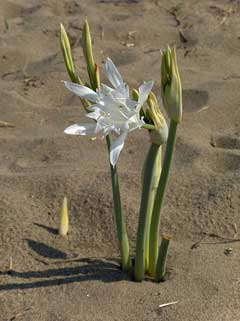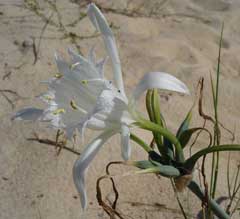 |
|
http://commons.wikimedia.org/wiki/User:Stemonitis |
 |
| http://fr.wikipedia.org/wiki/Utilisateur:Bouba |
Translate this page:
Summary
Physical Characteristics

 Pancratium maritimum is an evergreen Bulb growing to 0.5 m (1ft 8in) by 0.3 m (1ft).
Pancratium maritimum is an evergreen Bulb growing to 0.5 m (1ft 8in) by 0.3 m (1ft).
See above for USDA hardiness. It is hardy to UK zone 8 and is frost tender. It is in leaf all year, in flower in June. The species is hermaphrodite (has both male and female organs).
Suitable for: light (sandy) soils and prefers well-drained soil. Suitable pH: mildly acid, neutral and basic (mildly alkaline) soils. It cannot grow in the shade. It prefers dry or moist soil. The plant can tolerate maritime exposure.
UK Hardiness Map
US Hardiness Map
Synonyms
Plant Habitats
Cultivated Beds; South Wall. By. West Wall. By.
Edible Uses
Edible Parts: Root Seed
Edible Uses:
Bulb - cooked[2, 105]. This report is somewhat dubious since there are reports that the bulb is poisonous. Seed[89]. No further details are given.
References More on Edible Uses
Medicinal Uses
Plants For A Future can not take any responsibility for any adverse effects from the use of plants. Always seek advice from a professional before using a plant medicinally.
None known
References More on Medicinal Uses
The Bookshop: Edible Plant Books
Our Latest books on Perennial Plants For Food Forests and Permaculture Gardens in paperback or digital formats.

Edible Tropical Plants
Food Forest Plants for Hotter Conditions: 250+ Plants For Tropical Food Forests & Permaculture Gardens.
More

Edible Temperate Plants
Plants for Your Food Forest: 500 Plants for Temperate Food Forests & Permaculture Gardens.
More

More Books
PFAF have eight books available in paperback and digital formats. Browse the shop for more information.
Shop Now
Other Uses
Fibre
The woolly hairs on the inside of the seed coat (should this say the seed case?) are used to weave felt shoes and other garments[89, 148].
Special Uses
Scented Plants
References More on Other Uses
Cultivation details
Requires a light very well drained sandy soil in a very sunny position[42]. Requires a warm sheltered position when grown outdoors in Britain[200]. Requires a hot dry summer in order to fully ripen its bulb, it is more easily grown in a bulb frame in Britain[200]. Tolerates temperatures down to about -5°c[200], it is only hardy in the milder areas of Britain, requiring protection even there in the winter[1]. The bulb should be planted deeply and rapid spring growth should be encouraged[1]. Another report says that plants are easily grown outdoors in Britain but that the leaves are susceptible to frost damage and the plant does not flower well in an average British summer[90]. The flowers have an exotic lily scent[245].
References Carbon Farming Information and Carbon Sequestration Information
Temperature Converter
Type a value in the Celsius field to convert the value to Fahrenheit:
Fahrenheit:
The PFAF Bookshop
Plants For A Future have a number of books available in paperback and digital form. Book titles include Edible Plants, Edible Perennials, Edible Trees,Edible Shrubs, Woodland Gardening, and Temperate Food Forest Plants. Our new book is Food Forest Plants For Hotter Conditions (Tropical and Sub-Tropical).
Shop Now
Plant Propagation
Seed - best sown as soon as it is ripe in a greenhouse[200]. Pre-soak stored seed for 1 hour in warm water and then sow in spring in a warm greenhouse in a light sandy soil[1]. Germination usually takes place within 1 - 3 months at 22°c. Sow the seed thinly so that the seedlings can be left undisturbed in the pot for their first two years of growth. Give them an occasional liquid feed in the growing season to ensure they do not become nutrient deficient. When the plants become dormant in late summer, pot up the small bulbs placing 2 bulbs in each pot. Grow them on for another one or two years in the greenhouse before planting them out when they are dormant in late summer. Division of offsets when the plant dies down in late summer.
Other Names
If available other names are mentioned here
Native Plant Search
Search over 900 plants ideal for food forests and permaculture gardens. Filter to search native plants to your area. The plants selected are the plants in our book 'Plants For Your Food Forest: 500 Plants for Temperate Food Forests and Permaculture Gardens, as well as plants chosen for our forthcoming related books for Tropical/Hot Wet Climates and Mediterranean/Hot Dry Climates. Native Plant Search
Found In
Countries where the plant has been found are listed here if the information is available
Weed Potential
Right plant wrong place. We are currently updating this section.
Please note that a plant may be invasive in one area but may not in your area so it’s worth checking.
Conservation Status
IUCN Red List of Threatened Plants Status :

Growth: S = slow M = medium F = fast. Soil: L = light (sandy) M = medium H = heavy (clay). pH: A = acid N = neutral B = basic (alkaline). Shade: F = full shade S = semi-shade N = no shade. Moisture: D = dry M = Moist We = wet Wa = water.

Expert comment
Author
L.
Botanical References
45200
Links / References
For a list of references used on this page please go here
Readers comment